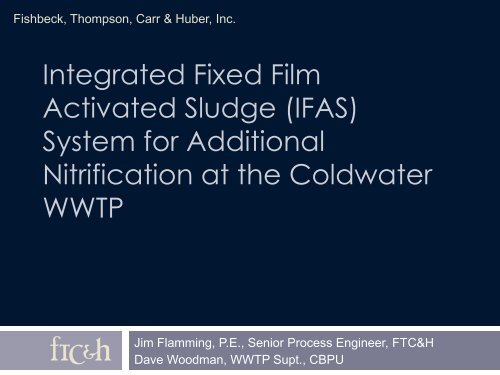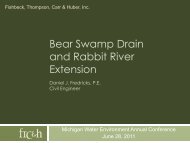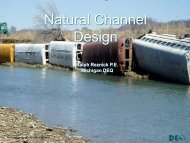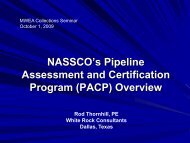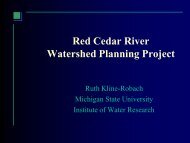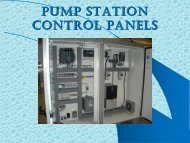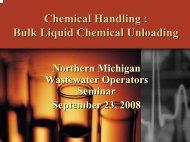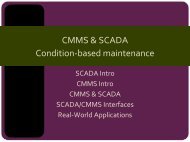Integrated Fixed Film Activated Sludge (IFAS) System for Additional ...
Integrated Fixed Film Activated Sludge (IFAS) System for Additional ...
Integrated Fixed Film Activated Sludge (IFAS) System for Additional ...
- No tags were found...
You also want an ePaper? Increase the reach of your titles
YUMPU automatically turns print PDFs into web optimized ePapers that Google loves.
Fishbeck, Thompson, Carr & Huber, Inc.<strong>Integrated</strong> <strong>Fixed</strong> <strong>Film</strong><strong>Activated</strong> <strong>Sludge</strong> (<strong>IFAS</strong>)<strong>System</strong> <strong>for</strong> <strong>Additional</strong>Nitrification at the ColdwaterWWTPJim Flamming, P.E., Senior Process Engineer, FTC&HDave Woodman, WWTP Supt., CBPU
Coldwater WWTPOwned by Coldwater BPUDesign Average Flow is 3.2 MGDPeak Flow is 8 MGDBOD, TSS, Ammonia,Phosphorus, andPathogen RemovalSurface Water Discharge
Coldwater WWTP
What Drove Project? New discharge permit issued August 2007Included seasonal ammonia limits 2 mg/l from May through November Previously was report only Routine violations through spring and summer 2007BPU hired FTC&H to investigate possible solutions
Engineering Reviewand Problem SolvingReviewed secondary treatment system Trickling Filter/Solids Contact (TF/SC) processTricklingFilterAeration BasinSecondary Clarifier Three, 115 ft. dia X trickling filters filled with 7 ft. of crossflow plastic media Followed by two parallel 152,000-gallon aeration basins(each 70’ X 20’ X 14.5’ deep)
Engineering Reviewand Problem Solving Expansion of aeration basins difficult due tohigh groundwater level at site. Evaluated expansion of trickling filters Discussed options with Brentwood Industries Concrete tanks with aluminum domes 4th trickling filter would be expensive Investigated potential <strong>for</strong> upgrading aerationbasins with <strong>IFAS</strong> media
<strong>IFAS</strong> <strong>System</strong>s Submerged media carriers added toactivated sludge aeration basins Significantly increases biomass inventory Little to no increase in solids loadingto final clarifiers Increases sludge age – good <strong>for</strong>nitrifying bacteria Come in different varieties
<strong>IFAS</strong> <strong>System</strong>s Suspended media Poured into aeration basin Moves freely in mixed liquor Retained in basin typicallywith in-basin screens Various manufacturers
<strong>IFAS</strong> <strong>System</strong>s <strong>Fixed</strong> Media – i.e. AccuFAS <strong>IFAS</strong> (BrentwoodIndustries)
Preliminary Design BioWin ModelingTF EffluentAeration BasinEffluent<strong>Sludge</strong> Used to size aeration requirements and predicteffluent quality under various flow scenarios. Both basins in operation One aeration grid out of service One basin in operation,one out of service
BioWin ResultsTwo Basins -Both at FullCapacityBasin Number(s) #1 and #2Maximum Influent AmmoniaLoad per Basin, ppdTotal Maximum InfluentAmmonia Load, ppdEffluent Ammonia per Basin,mg/lCombined EffluentAmmonia, mg/lEffluent Ammonia Load perBasin, ppdTotal Effluent AmmoniaLoad, ppdAir Supply Rate per Basin,scfmOne Basin at Full Capacity;One Basin with One AerationGrid Out-of-Service#1 (FullCapacity)#2 (ReducedCapacity)One Basin Only (ToMeet WinterRequirements)Either #1 or #2 (notboth, one out of service)280 280 170 NA560 450 4001.3 1.3 2.8 NA1.3 2.0 12.017 17 37 NA34 54 3201,269 1,269 1,990 NATotal Air Supply Rate, scfm 2,538 3,259 1,410* - Assuming the following trickling filter effluent characteristics and operating conditions: Flowrate =3.2 mgd; Total BOD = 40 mg/l; TSS = 165 mg/l; Alkalinity (as CaCO 3 ) = 5 mmol/l; Temperature = 18degrees C; MLSS = 4,000 – 4,250 mg/l; RAS/Q = 65%
Final Design Tank volume was fixed and maximum mediafill possible was 60% Existing blowers had a firm capacity of 900scfm ; firm capacity required = 2,538 scfm Redundancy requirements needed to be met<strong>for</strong> both diffuser and blower capacity. <strong>Additional</strong> blower capacity required –presentation Session 2 at 2:30 pm today
Final Design
Final Design
Installation
Installation
Installation
Installation
Installation
Installation
Installation
Installation
ResultsSecondary effluent >discharge limit 60 timesbe<strong>for</strong>e <strong>IFAS</strong>Secondary effluent >discharge limit 43 timesafter <strong>IFAS</strong> startup …… 41 of those times wereas a result of industrialplant failure
Conclusions <strong>IFAS</strong> can be applied to existing secondarysystems to reduce effluent ammoniaconcentrations. <strong>IFAS</strong> increases sludge age, increasing thetotal inventory of nitrifiers, without increasingloads to secondary clafifiers. These systems are very robust. <strong>Fixed</strong> media <strong>IFAS</strong> systems (such as theAccuFAS system) can be added withoutaffecting existing hydraulic profiles.
Fishbeck, Thompson, Carr & Huber, Inc.THANK YOU!Any Questions?Thank you!


